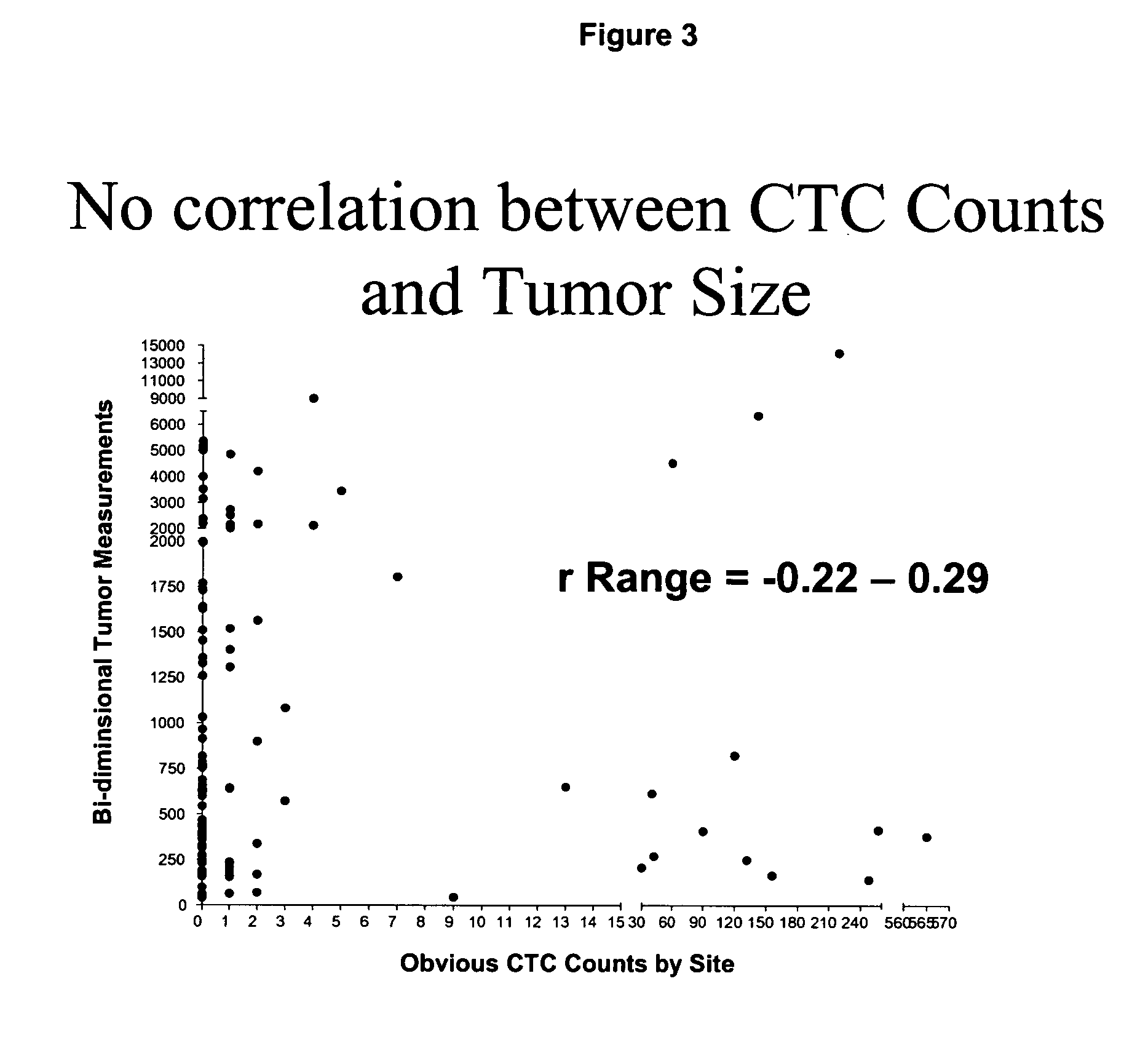Circulating tumor cells (CTC's): early assessment of time to progression, survival and response to therapy in metastatic cancer patients
a tumor cell and tumor prognosis technology, applied in the field of cancer prognosis and survival in metastatic cancer patients, can solve the problems of difficult detection and elimination, inability to treat all patients successfully, and inability to improve the survival rate of cancer patients over the past two decades, so as to achieve less side effects, improve survival rate, and improve the effect of quality of li
- Summary
- Abstract
- Description
- Claims
- Application Information
AI Technical Summary
Benefits of technology
Problems solved by technology
Method used
Image
Examples
example 1
Enumeration of Circulating Cytokeratin Positive Cells Using CellPrep™
[0044] Cytokeratin positive cells are isolated by the CellPrep™ System using a 7.5 ml sample of whole blood. Epithelial cell-specific immunomagnetic fluid is added and incubated for 20 minutes. After magnetic separation for 20 minutes, the cells bound to the immunomagnetic-linked antibodies are magnetically held at the wall of the tube. Unbound sample is then aspirated and an isotonic solution is added to resuspend the sample. A nucleic acid dye, monoclonal antibodies to cytokeratin (a marker of epithelial cells) and CD 45 (a broad-spectrum leukocyte marker) are incubated with the sample for 15 minutes. After magnetic separation, the unbound fraction is again aspirated and the bound and labeled cells are resuspended in 0.2 ml of an isotonic solution. The sample is suspended in a cell presentation chamber and placed in a magnetic device whose field orients the magnetically labeled cells for fluorescence microscopic...
example 2
Assessment of the Tumor Load: Comparison between Radiographic Image Analysis and the Absolute Number of CTC's.
[0045] Radiographic measurements of metastatic lesions are currently used to assess tumor load in cancer patients with metastatic disease. In general, the largest lesions are measured and summed to obtain a tumor load. An example of a bidimensional measurement of a liver metastasis in a breast cancer patient is illustrated in FIG. 2A. A model depicting the necessity for measuring tumor load in the blood stream is illustrated in FIG. 2B as a measurement of the actual active tumor load, and thus a better measure of the overall activity of the disease. To determine whether or not the absolute number of CTC's correlated with the dimension of the tumor measured by imaging a prospective study in patients with MBC was performed.
[0046] The Cell Spotter® System was used to enumerate CTC's in 7.5 ml of blood from 69 patients with measurable MBC. Tumor load was assessed by bi-dimens...
example 3
Assessment of the Tumor Load: Comparison Between Changes in the Radiographic Image and Changes in the Absolute Number of CTC's.
[0049] Radiographic imaging is the current standard to assess whether a particular disease is responding, stabilizing, or progressing to treatment. The interval between radiographic measurements must be at least 3 months in order to give meaningful results. Consequently, a test that could predict response to therapy earlier during the treatment cycle would improve the management of patients treated for metastatic diseases, potentially increase quality of life and possibly improve survival. In this study, patients starting a new line of treatment for MBC were assessed to determine whether a change in the number of CTC's correlated with a change in patient status as measured by imaging.
[0050] The Cell Spotter® System was used to enumerate CTC's in 7.5 ml of blood in MBC patients about to start a new therapy, and at various time points during the treatment c...
PUM
| Property | Measurement | Unit |
|---|---|---|
| time | aaaaa | aaaaa |
| magnetic field | aaaaa | aaaaa |
| density | aaaaa | aaaaa |
Abstract
Description
Claims
Application Information
 Login to View More
Login to View More - R&D
- Intellectual Property
- Life Sciences
- Materials
- Tech Scout
- Unparalleled Data Quality
- Higher Quality Content
- 60% Fewer Hallucinations
Browse by: Latest US Patents, China's latest patents, Technical Efficacy Thesaurus, Application Domain, Technology Topic, Popular Technical Reports.
© 2025 PatSnap. All rights reserved.Legal|Privacy policy|Modern Slavery Act Transparency Statement|Sitemap|About US| Contact US: help@patsnap.com



